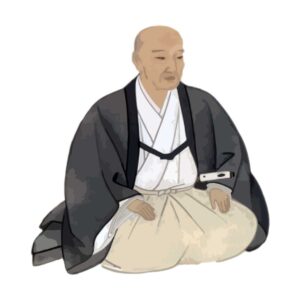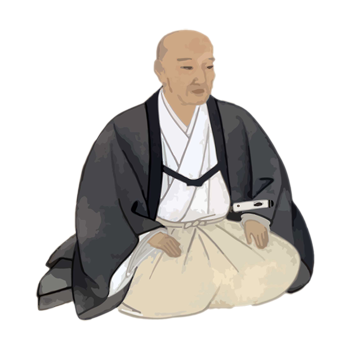
A tea master in the early days of the tea ceremony. Born in 1502. Born in 1502, his family name was Takeno and his first name was Nakamura. He was also known as Shingoro. He was also known as Daikokuan and Ikkan. He was a descendant of the Takeda clan of Wakasa Province (Fukui Prefecture). Under the patronage of the Miyoshi clan, he became wealthy as a leather handler and armorer. Nakamura had an early interest in learning the arts and sciences, and in 1525, at the age of 24, he went to Kyoto to study poetry under Sanjonishi Sanetaka.
In 1532, at the age of 31, his mother died, and he shaved his hair and assumed the name of Shao-o. 1549, at the age of 48, Obayashi Sotanto of Nanshuji Temple in Sakai gave him the title of “Ippan”. During this period, he traveled back and forth between Kyoto and Sakai, and is said to have built the Daikokuan hermitage by the Shijo barbershop in Kyoto. He studied tea under Sori Fujita, Sogo Jyushiya, and Souchen in Shimogyo, and deepened the direction of Wabicha by combining the tea tradition of Shuko with the sensibilities of a wealthy Sakai merchant and his own education in Japanese studies, eventually leading his disciple Sen no Rikyu, the great master of chanoyu. In the “Yamakami Souji Ki,” it is written, “Up to the time of my death, I had the style of Hachijukou, but after that, Shao-ohaku completely changed his style, and he became a master of the tea ceremony. He also taught that we should respect the originality of Fujiwara no Teika’s “Preface to the Outline of Poetry,” which was given to him by Sanetaka, and that we should make Teika’s “Look over and you will see neither flowers nor autumn leaves, and the autumn evening twilight at Uranotomaya” our philosophy of tea, and that “After an ancient person becomes a tea ceremony master, he should be a person who is only concerned with a single kind of tool, and not a person who is only concerned with a few. In the words of the renga poem by Shinkei Houshi, the renga is said to be withered and cold, and the tea ceremony is said to have achieved the same result, as Shaowo always said to Tsuji Genzai” (Yamakami Souji Ki). The famous Shao-Ogaki sack cabinet is also mentioned as follows: “The sack cabinet should not be painted or maki-e, but should be just as it is, and the object should be in the same place as it is” (Rikyu, “Letter to Nomura Sokaku”). Based on these ideas, Shao-oho changed the four-and-a-half-tatami-mat style of the tea room to the kuso-style, which had been used since Shuko’s time, and proposed Wabi-utensils such as the ori-taiko, kurodana, earthenware furnace, jujube tea caddy, wooden curved tea caddy, bamboo lid rest, and bamboo jizai, and explored new values in Wabi-ware in pottery, including Nanban-headed water jar, Shigaraki oni oke mizuji, and Bizen mene oke kensui. At the same time, however, Shao-o also possessed a large number of old Chinese masterpieces, and his collection of new and old items is said to have numbered as many as 60 kinds, according to his discernment: “All of the 10,000,000 tools of the day were called out to him with the clear eyes of Shao-o” (“Yamakami Sojiki”). Most of the wealthy tea masters in Sakai at the time, including Miyoshi Saneyoshi and other great masters of the tea ceremony, were Shao-o’s students. He died on October 29, 1555, at the age of 54.


